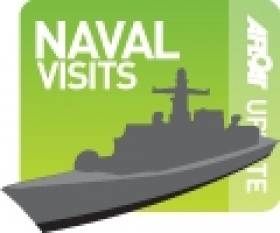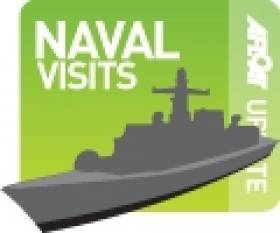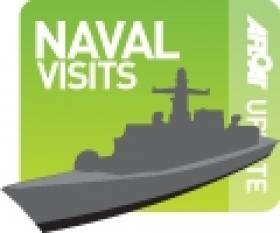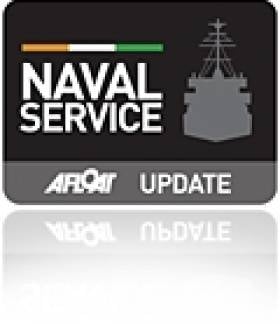Displaying items by tag: Naval Visits
Visiting NATO Naval Flotilla Gather in Cork's City Quays
#NATOnavalVisitors – A flotilla of naval vessels from NATO's Standing Mine Countermeasures Force are on a visit to Cork this bank holiday weekend following a fortnight of exercises, writes Jehan Ashmore.
More than 300 sailors from the following European navies; Belgium, Germany, Netherlands, Norway and Poland have docked along the city's central quays. They arrived into Cork Harbour on Thursday under the escort of the Naval Service's OPV L.E. Aisling (P23) which too had tied-up on the city quays.
The naval flotilla will be open to the public between (2-5pm) on Sunday and Monday.
Since the start of this year, the force group six-strong mine-clearance flotilla, have carried out operations throughout the Baltic, North Sea and the Low Countries.
Next Tuesday, the flotilla are heading to UK waters followed by Faroese Islands and Iceland and in the north Atlantic, an area where the NATO force task group were first deployed having been formed in 1973.
The current operations are not just to make shipping safe from recovering explosives devices dating from the last two world wars but are also to combat international terrorism threats from the sea.
Among the eclectic looking naval ships is the Norwegian Navy's HNOMS HINNOEY (M343) -scroll down the page.This mine-clearance catamaran craft and her fleetmates (see list below) are berthed along the north and south quays close to the Port of Cork Company headquarters.
BNS BELLIS (M916) –Belgium Navy
HNLMS URK (M861) -Royal Netherlands Navy
FGS WEILHEIM (M1059) –German Navy
ORP CZERNICKI (511) – Polish Navy (noting NATO symbol on funnel)
ORP CZAJKA (624) –Polish Navy
HNOMS HINNOEY (M343) – Norwegian Navy
NATO which stands for the North Atlantic Treaty Organization is an alliance of countries from Europe and North America.
The organization provides a unique link between these two continents for consultation and cooperation in the field of defence and security, and the conduct of multinational crisis-management operations.
French Frigate on Festival Visit to Dublin
#FrenchFrigate –French anti-submarine frigate De Grasse (D 612) is currently on a courtesy call to Dublin Port, having arrived yesterday for the St. Patrick's festival weekend, writes Jehan Ashmore.
A crew of more than 200 operate the 4,650 tonne displacement vessel which is based in Brest, where she is primarily deployed on operations along the Atlantic front.
The frigate was built in 1972 and entered service five years later. Among her armoury are 6 Exocet MM 38 missiles and there is a 155m² helicopter hanger, where she can carry up to two Lynx helicopters.
De Grasse is moored at Ocean Pier (berth 35) which is nearly opposite the Poolbeg Yacht & Boat Club Marina, Ringsend. She is scheduled to remain in port until Tuesday morning.
Duke Class Frigate to Dock in Dublin Port
#FrigateVisit-The Royal Navy Type 23 Duke Class frigate HMS Richmond (F239) is to make a weekend courtesy call to Dublin Port, with an arrival to the capital this afternoon, writes Jehan Ashmore.
The 4,900 displacement frigate commissioned in 1995 has a top speed 28 knots and a crew complement of 185. She and her 12 sisters are among the most tried and tested in the fleet, having pounded Saddam Husseins defences on the Al Faw peninsula in the opening hours of the Iraq campaign a decade ago in 2003.
HMS Richmond has undergone an upgrade to sensors and weapons systems, where Seawolf Mid-Life Update (SWMLU) are now fitted that will improve the ship's ability to meet the evolving capability of anti-ship missiles. In addition the frigate has 30 mm Automated Small Calibre Gun (ASCG) system making her a formidable and modern weapons platform.
Liverpool’s ‘Lusty’ Valentine Marks Changing Times for Aircraft-Carriers
#AircraftCarriers – The Royal Nay's last 'Invincible' aircraft carrier, HMS Illustrious (R06) affectionately known by her crew as 'Lusty', which these days serves as a helicopter commando-carrier, docked on St. Valentine's Day at Liverpool Cruise Terminal, writes Jehan Ashmore.
As previously reported, during her five-day city courtesy call, she is to be open to the public this weekend. The call to Merseyside could be her last as the 22,000 displacement tonnes vessel is due to pay off in early 2014. She was launched in 1978 from Swan Hunter on the Tyne and over the next 32 years the 209m long vessel has served an illustrious career including her role in carrying 'Harrier' VSTOL jump jets.
The Portsmouth based HMS Illustrious is one of four Royal Navy core amphibious vessels, and in her place are a pair of Queen Elizabeth class 65,000 displacement tonnes aircraft –carriers currently under construction. However until delivered, HMS Ocean (L12) a helicopter carrier of 21,500 tonnes will replace Illustrious, after completion of a £65m refit at Devonport Royal Dockyard early next year.
Minehunter that Served in Libya Anchors in Dublin Bay
#NAVAL ANCHORAGE – A Royal Navy mine-hunter HMS Bangor (MI09) which took part in Libyan operations last year, anchored overnight in Dublin Bay during the north-easterly gale force winds, writes Jehan Ashmore.
Unlike the majority of vessels which anchor in the south of the bay, she unusually took anchorage north of the main shipping lane for Dublin Port by positioning off Sutton South on Howth Peninsula.
HMS Bangor is a Sandown class mine-hunter and she is due to continue her northbound passage through the Irish Sea to spend Easter at her affiliated namesake town on the shores of Belfast Lough.
Her last call to Bangor was to celebrate Armed Forces Day 2010 and also in that year she called to Dublin, click HERE for that report.
On this occasion she will tell of her role supporting NATO operations off the coast of Libya. During Operation Unified Protector, the mine-hunter's task involved 120 days of non-stop action by scouring miles of sea bed off Libya as the battle between rebels and Colonel Gaddafi raged.
Built in 1999 by Vosper Thorneycroft, Southampton, the glass-reinforced plastic (GRP) ship and her 34 crew undertook the painstaking work. This paid off when the 55m vessel found a 2,400-pound (1000kg) mine and a torpedo lying on the seabed off the port of Tobruk in eastern Libya.
Both were safely destroyed using the ship's Sea Fox system – an underwater drone armed with explosive charges.
HMS Bangor is among seven of her class based at on the Clyde, Scotland. They each displace 600 tonnes and have a range of 2,500 nautical miles. For further details about the class, click HERE.
University Challenge Heads for Cork
#NAVAL VISITS – Two small University Royal Naval Units (URNU) patrol training boats of the Royal Navy are due to call to Cork city centre along South Customs House Quay this afternoon, writes Jehan Ashmore.
The pair are HMS Exploit (P167) and HMS Express (P163) and they belong to a 14-strong P2000 Archer Fast Inshore Patrol Class. They form the First Patrol Boat Squadron and their primary role is to support the URNU but they also contribute to a wide range of fleet tasking.
Each vessel displaces 54 tonnes and has a crew of five on a boat that is just over 20m and draws a draft nearing 2m. Top speed is 22 knots and they can cover a range of 550 nautical miles.
HMS Exploit is the Birmingham University Royal Navy Unit's Training Patrol vessel, although the unit covers a wide area, taking undergraduates from eight Universities in the region. She was built by Vosper Thornycroft and commissioned in 1988. The boat is berthed in Penarth Marina, near Cardiff.
Likewise HMS Express is based at Penarth, she too provides sea training and offers an insight into the modern Royal Navy for Wales URNU undergraduates drawn from Cardiff, Swansea and Glamorgan Universities and University of Wales Institute Cardiff. Last year she took part in the Three Peaks Challenge.
The patrol boats follow last month's call also to the city of the Marine Protection Vessel (MPV) Jura which at 84m long makes her the largest of the three-strong Marine Compliance Scotland fleet. On that occasion she docked opposite at the North Customs House Quay.
Dutch Navy Stealth Frigate to Visit Cork City Centre
#NAVY VISITS -HNLMS Evertsen (F805) a Dutch naval frigate with a crew complement of 200 is due to make a weekend courtesy call to Cork City, berthing at J.J. Horgan's Wharf, writes Jehan Ashmore.
She is a sister of HNLMS De Ruyter (F804) which docked in Dublin Port last month, as previously reported in this section. The 144m frigates form two of a total of four De Zeven Provinciën-class air-defence and command frigates (LCF). The class present sharp angular lines (see PHOTO) due to stealth design technology to minimise radar signature detection.
Armament consists of a bow-mounted Oto Breda 127 mm cannon, vertical launch systems for various missile types, a 'goalkeeper' rapid-fire gun, an Oerlikon 20mm machine gun and a Mk. 46 Torpedo weapon system. At the stern she can carry a Lynx or NH-90 helicopter.
They displace 6,050 tonnes and propulsion plant are 2 x Wärtsilä 16 V26 diesel motor engines (13,600 hp total), 2 x Rolls Royce Spey SM 1A gas turbines (52,300 hp total). The class can achieve 30 knots and entered service between, 2001-2005 from the Royal Schelde Group shipyard in Flushing.
Anglo-Irish Relationships
#NAVAL VISITS- HMS Tyne (P281) the leadship of four River-class Fishery Protection Vessels is due to dock in Dublin Port tomorrow, in the meantime her allocated berth is currently taken by a former Royal Navy (RN) vessel now serving in the Irish Naval Service (INS), writes Jehan Ashmore.
The INS L.É. Ciara (P42) docked at Sir John Rogersons Quay (berth No.8) yesterday evening after spending the previous day with a call to Dun Laoghaire Harbour's St. Michaels Wharf. Tomorrow she is due to depart in advance of HMS Tyne's morning arrival.
Unusually she and her three sisters are leased to the RN from BAE Systems (who retain responsibility for any major maintenance and upkeep) and shipbuilding partners, Vosper Thornycroft, Southampton which built all of the River-class. To read more about the quartet click HERE.
L.É. Ciara was originally launched as HMS Swallow (P242) at Hall Russell Shipyard, Aberdeen and in 1984 was commissioned for the RN, forming one of five 'Peacock' class coastal patrol vessels (CPV). She served her entire RN career with sisters designed specifically for the Hong Kong Squadron.
In 1988 the INS purchased her alongside a sister HMS Swift (P243) and the pair set sail from the UK colony for Cork Harbour. L.É. Ciara and her sister which became L.É. Orla (P41) were commissioned into the service after a ceremony performed by An Taoiseach C.J. Haughey at the Naval Base in Haulbowline.
Amongst the eight-strong INS fleet is L.É. Emer (P21) commissioned in 1978, an improved version of the Deirdre-class offshore patrol vessel (OPV). She appeared along with a sister of the River-class ship, HMS Severn in the Irish language river series 'Abhainn' which returned to our screens on RTE 1 last month, during the episode about the River Foyle /An Feabhal. The naval vessels were attending 'Foyle Days' in May as previously reported on Afloat.ie
- Irish Naval Service
- Dublin Port
- naval service
- Royal Navy
- Dun Laoghaire Harbour
- Peacock Class
- Hall Russell
- Foyle Days
- Naval Visits
- River Foyle
- Coastal Patrol Vessels
- HMS Tyne
- RN
- INS
- Hong Kong Squadron
- Fishery Protection Ship
- BAE Systems
- Vosper Thornycroft
- Haulbowline Naval Base
- Deirdreclass
- Abhainn TV series
- HMS Severn
- Irish River TV series Abhainn
Duke-Class Frigate Docks In Dublin
She measures 133m (436ft) long and on a beam of 16.1m (52.9ft) and has a crew compliment of 185 in total. An array of highly sophisticated arnament is packed on board in addition she can convey a Lynx helicopter. Propulsion is derived from a combined use of diesel and gas (CODLAG) .To read more about the penultimate Type 23 class and her sisters click HERE
Naval Service OPV On Visit to Russia and Baltic States
Since Tuesday the offshore patrol vessel (OPV) has been berthed in the Baltic city of St. Petersburg. Her naval officers laid a wreath at the Piskarevskoye Memorial Cemetery. Also visited was the Central Naval Museum and the naval cruiser Aurora, where one of the first incidents of the 'October' Russian revolution took place in 1917.
Irish Ambassador to Russia Philip McDonagh boarded the L.E. Roisin yesterday to highlight Irish-Russian bi-lateral relationships and co-operation between the two countries in areas of economic, culture, education and tourism. In the first-half of 2010 bi-lateral trade with Russia was up 66% and St. Petersburg is the most important economic centre after Moscow.
The trade mission follows last year's visit of president Mary McAleese who became the first Irish head of state to visit Russia. On her visit which included St. Petersburg, she signed a protocol on partnership and co-operation between the Russian city and Dublin during the third St. Petersburg International Innovation Forum.
In March of this year representatives from St. Petersburg took part in the Russian Culture Festival in Dublin. Three months later in July, the Irish capital was visited by the Russian Naval destroyer Admiral Chabanenko (650), the flagship of the countries Northern Fleet. For more on that visit of the Udaloy –II class destroyer click HERE.
L.E. Roisin is not the first Irish Naval Service vessel to visit the Russian Federation as this accolade goes to the flagship L.E. Eithne (P31) which called to St. Petersburg in 2003.
- Irish Naval Service
- Dublin Port
- naval service
- Ports and Shipping News
- LE Eithne
- Naval Visits
- Navy News
- Irish navy news
- L.E. Roisin
- LE Roisin
- Irish OPV vessels
- St. Petersburg trade mission
- IrishRussian trade
- Irish Ambassador to Russia
- President Maru McAleese
- Irish trade delegation to Russia
- Lt Cdr Peter Twomey
- Philip McDonagh
- Adi Roche
- Chernobyl Children's Project





































































